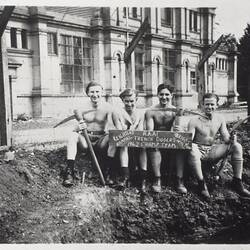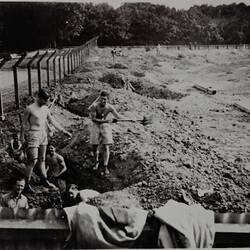During World War II, the Royal Exhibition Building (REB, then called simply the Exhibition Building) in Melbourne was occupied by the RAAF and the WAAAF- mostly non-crew aircraftmen and aircraftwomen, trainers, medical personnel and administrators. Of the few photographs that have been preserved, some are formal portraits; some show marching; and a few capture everyday moments such as trench-digging in the grounds around the Exhibition Building. Two of these photos show RAAF serviceman Alan Walton.
Alan Laurence (or Lawrence) Walton, service no. 10721, was born in Melbourne on 11 April 1918 and enlisted on 27 June 1940, aged 22. He was a typewriter mechanic at Stott and Hoare, livng with his mother at 84 William St, East St Kilda. His Recruitment Enquiry Form assessed him as 'sober, honest and respectable'.
Alan became a trainee fitter, and instrument maker and repairer during the war. He was posted to 'RAAF Exhibition Buildings' ('No. 1. S.T.T. Exhibition') on 1 February 1942. During Easter 1942 he dug slit trenches in the grounds of the Exhibition Building with fellow servicemen Graham Keightley, Ted Hammill, Dennis John Varigos, Jack Van Emden and Clem Gill. They are depicted in two photos in Museums Victoria's collection: SH 960566 and SH 960567. Years later, around 1995, Alan remembered his time at the Exhibition Building in an interview now held in Museums Victoria's collection (HT 9594). He explains that in November 1941 he was 'posted down to do an instrument-makers' course at the Showgrounds. He was then part of a group of 37 who took a course at Melbourne Tech while staying at the Exhibition Building. He remembers that 'The Exhibition itself . was certainly no Hilton'. They slept on the balconies, in cubicles with four beds. There were no lockers - 'everything was out on display' - and theft was rife. At night the lights were so dim it wasn't possible to read. It was a dusty place, and dust used to come through the floorboards. The site hadn't been maintained for at least 10-15 years. The organ 'up the end' was in a bad state of disrepair too, with pipes squashed. Alan remembers a canteen in the basement, and possibly also the post office.
Each weekday the group would march down to the Melbourne Tech for tuition, then back to the Exhibition Building for lunch, which took two hours including marching and lunch. They then had to march back to Melbourne Tech for the afternoon's tuition, then returned to the Exhibition Building about 5.30pm. On Saturdays they were 'allowed the joys of trench digging' (suggesting the photos were taken on Easter Saturday, 4 April 1942), PT, or lectures on subjects such as bomb disposal or avoiding venereal diseases.
Alan spent three months at the Exhibition Building, then on on 24 April 1942 was sent back to the Showgrounds ('Ascot Vale' in his records) for another three weeks.
He was then was posted back to Wagga, then in February 1943 was sent to Gorrie Airfield, Northern Territory. He was based in Darwin April - August 1943, before returning to Gorrie.
Alan spent the rest of the war as an instrument maker, and was promoted to corporal in July 1944.
He was discharged on 18 December 1945 at the rank of corporal at 2 Aircraft Depot (Richmond, NSW).
References
Alan Laurence Walton, National Archives of Australia service records, barcode 4557584.
More Information
-
Keywords
-
Authors
-
Article types


